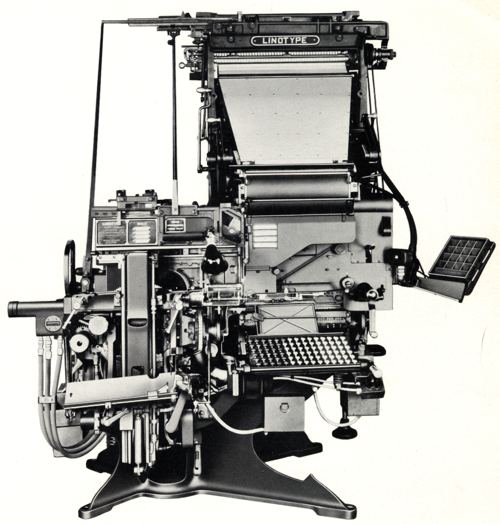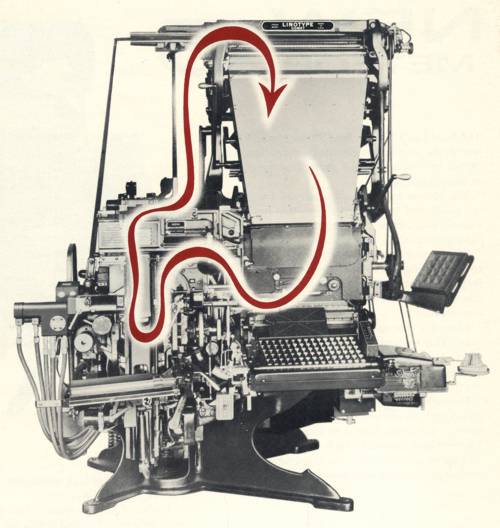Category: Historical
Historical items
Rangemaster Model 35

The material on this page is taken from a brochure published in circa 1960 by the Mergenthaler Linotype Company. The brochure showcased the company’s latest machines and innovations.
No other composing machine can match the range, capacity and versatility of the Rangemaster Model 35 Mixer without using auxiliary magazines.
With the Blue Streak 35, the operator can keyboard large headlines and advertising display, eliminating slow hand setting. He may also keyboard the most intricate two- and three-line food store and other mixed composition, eliminating cut-ins and reducing make-up time.
Linotype Rangemaster Models

The material on this page is taken from a brochure published in circa 1960 by the Mergenthaler Linotype Company. The brochure showcased the company’s latest machines and innovations.
Only Linotype produces a lineCasting machine with all the unique features of the Model 33 Rangemaster.
Intertype Factory, 1966
Many thanks to Stan Coutant for allowing these photographs to be used on Metal Type. Stan was an Intertype Operator from 1959 to 1978 – a period he describes as “one of the most enjoyable and rewarding jobs I have ever had.”
In Stan’s own words: “In 1966 I had occasion to travel to New York, my first and only trip to the East Coast. Since there was adequate time before I departed, I wrote to the folks at Intertype Corporation and asked about taking a tour of the factory.
Blue Streak Model 31
The material on this page is taken from a brochure published in circa 1960 by the Mergenthaler Linotype Company. The brochure showcased the company’s latest machines and innovations, including the Linofilm System.
THE most widely-used linecasting machine in the world, the Model 31 Blue Streak Linotype is known as the “workhorse of the composing room” because it handles so many jobs so well.
Thorold Post, Ontario, Canada, c1920
Blue Streak Model 29 & 30

The material on this page is taken from a brochure published in circa 1960 by the Mergenthaler Linotype Company. The brochure showcased the company’s latest machines and innovations, including the Linofilm System.
The most varied and complex typesetting is simple for the 29, and is set directly from the keyboard.
Food-store ads, technical composition and dictionary work requiring roman, italic, bold, accents and special characters in the same line – the versatile 29 handles such difficult composition efficiently and economically.
Blue Streak Model 5 Meteor
The material on this page is taken from a brochure published in circa 1960 by the Mergenthaler Linotype Company. The brochure showcased the company’s latest machines and innovations, including the Linofilm System.
The basic Linotype, the Blue Streak Model 5 Meteor is the world’s favorite single-magazine line-caster.
Blue Streak Comet

The material on this page is taken from a brochure published in circa 1960 by the Mergenthaler Linotype Company. The brochure showcased the company’s latest machines and innovations.
The new, two-magazine Blue Streak Comet Linotype is the fast straight matter machine.
The Linotype Line
The material on this page is taken from a brochure published in circa 1960 by the Mergenthaler Linotype Company. The brochure showcased the company’s latest machines and innovations, including the Linofilm System.
The full brochure can be downloaded from the Metal Type Library – Typesetting section in PDF format.





